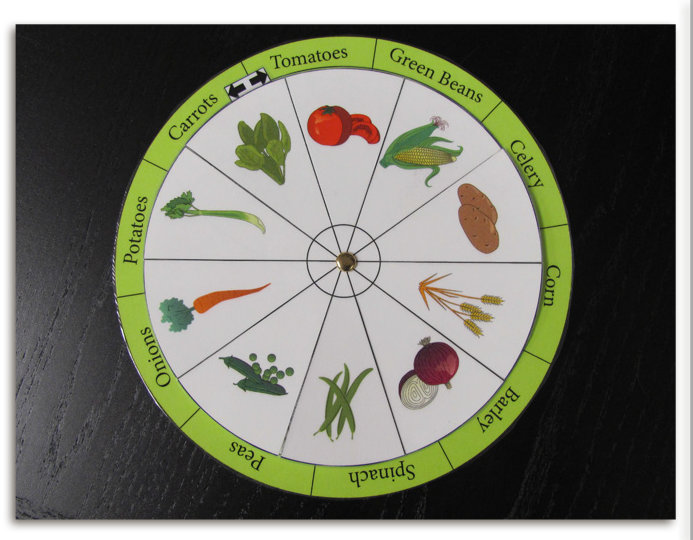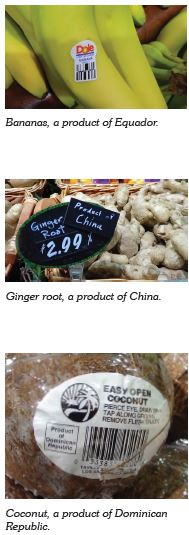Lesson Plan
Who Grew My Soup? (Grades 3-5)
Grade Level
Purpose
Students identify the source of the food they eat and investigate the processes and people involved in getting food from the farm to their spoon. Grades 3-5
Estimated Time
Materials Needed
Activity 1: Food/Farm Connection
- Who Grew My Soup? by Tom Darbyshire (book) or view a read aloud
- Fact Wheel (make sure that the “Shrink oversized pages to paper size” setting is not checked when printing)
- Metal brads, 1 per student
- Food samples
- Food/Farm Connection matching cards
Activity 2: Where Does Your Food Come From?
- Food item with product of origin label
- Where Does My Food Come From? activity sheets
- National Geographic's Mapmaker Interactive
Activity 3: Graphing Activity
- Examples of a fruit or vegetable in fresh, canned, frozen, and dried forms (enough for each student to sample)
- Sticky notes
Vocabulary
edible: suitable or safe to eat
nutritious: having a large amount of vitamins, minerals, or other nutrients
preserve: to prepare (food) so that it can be kept for a long period of time
processing: in agriculture, the alteration or modification, for the purpose of storage, transport, or sale, of an agricultural product
Did You Know?
- The oldest known vegetable is the pea.1
- Frozen foods were first introduced in the 1920s.2
- Consomme` soup was developed by a royal chef in the 1700s so that the French King could see his own reflection in the bowl.3
- The earliest evidence of our ancestors eating soup was 6000 B.C. It was hippopotamus soup!3
Background Agricultural Connections
When asked where their food comes from, many students will say that it comes from a grocery store or restaurant. Young children don’t always make the connection between agriculture and the food they consume every day.
One US farm produces enough food to feed 172 people worldwide, but farmers are not the only workers involved in making food available to the consumer.4 Agriculture employs more than 21 million American workers.5 These jobs include harvesting, storing, transporting, processing, packaging, and selling the food we eat. Farms are the source of almost all the food we consume. It is important for students to understand that grocery stores are food distribution centers, not the source of food.
Some of the food we eat everyday is grown in our own communities, but not all of the food we consume is grown locally. While most states produce their own milk, eggs, fruits, vegetables, and grains, the availability of certain foods depends upon season. The climate and soil of a particular region determines the types of foods that can be grown. Consumer demands influence the items that stores and restaurants offer. Many people want to be able to eat fresh fruits and vegetables in the middle of the winter or out of season. Exotic foods, such as star fruit, kiwi, and guava that are not grown in many areas of the United States are also desired. Grocery stores meet these demands by having food transported from other regions of the United States and even from other countries.
The activities in this lesson will help provide students with an understanding about where their food comes from and what it takes to produce their food. It will also promote a natural curiosity about how food affects their health while reinforcing food and agriculture as their connection to a better quality of life. Understanding what it takes to produce food will help students make the association between the land, farmers and ranchers, and the grocery store.
Engage
- Ask students to name their favorite kind of soup. Allow several children to answer. As each child answers, ask them what ingredients are used to make that soup. Make a list of the ingredients on the board.
- Begin discussing the source of each ingredient by asking students, "Where do these ingredients come from?"
- Transition to Activity 1 by introducing the Who Grew My Soup? book. Explain to your students that they are going to read about a boy named Phin and the soup he eats.
Explore and Explain
Activity 1: Food/Farm Connection
- Read the book Who Grew My Soup? by Tom Darbyshire.
- Ask the students to create a list recalling the ingredients in Phin’s soup (carrots, tomatoes, green beans, celery, corn, barley, spinach, peas, onions, potatoes).
 Cut out and assemble the Fact Wheel. Each student can make their own Fact Wheel, or it can be assembled prior to the lesson (one for each group).
Cut out and assemble the Fact Wheel. Each student can make their own Fact Wheel, or it can be assembled prior to the lesson (one for each group).
- Cut around the circle on page 1.
- Cut around the circle on page 2 and center on top of page 1.
- Cut around the circle on page 3. Cut on the dashed lines in between each ingredient, stopping at the circle in the center. Center page 3 on top of page 2.
- Using the sharp point of scissors, make a hole through the center dot of all three pages. Attach the pages together by placing a metal brad through the hole and securing.
- Divide the class into 10 groups. Assign each group a food from the list. Give the groups enough time to match their food with the picture and information on the fact wheel. Provide a few samples of the ingredients for students to taste or observe while each group shares the facts about their food.
- Ask the students if they think all of the ingredients in Phin’s soup can be grown in our state? (Your response will depend on your location.) Ask the students if they think they can buy these ingredients locally grown all year long. Discuss what factors would affect the availability of locally grown food.
- Pass one Food/Farm Connection card to each student. Allow the students to walk around the classroom and find the student who has their matching card. The students should match the food item with its farm source (ex. oatmeal—oats, French fries—potatoes, eggs—chicken, applesauce—apples). Discuss the connections as a class.
Activity 2: Where Does Your Food Come From?
- Prior to the activity, ask the students to find a food item with a product of origin label at home. (Be prepared with extra food and a computer at school for students who are unable to complete this assignment at home.)
- Have each student complete the Where Does My Food Come From? activity sheet by using National Geographic’s Mapmaker Interactive to find the distance between their food’s country of origin and the town in which they live. Instructions are found on the activity sheet. This can be completed as a homework assignment or in school depending on computer access.
- As a class, locate the origin of each child’s food on a world map. Students can label each location on the activity sheet world map. Compare the distances and determine whose food traveled the farthest and shortest distances.
- Discuss the different ways the food could have traveled to a local grocery store (truck, airplane, train, boat, etc.). What steps need to be taken to ensure that the food doesn't spoil before arriving at the market?
- What are some possible reasons the food traveled so far? Discuss how the climate of a particular location affects what foods can be grown there.
- Identify the different careers involved in getting food from the farm to the table (e.g., grower, harvester, truck driver, packagers, processors, warehouse operators, grocers, etc.).
Activity 3: Graphing Activity
- Bring examples of fruits and vegetables packaged in different ways (fresh, canned, frozen, dried).
- Give the students a sticky note that they will write their name on. Have students sample the same fruit or vegetable fresh, canned, frozen, and dried.
- Create a graph by writing fresh, canned, frozen, and dried on the bottom of the board. Explain that some foods may taste better cooked. Just because they don’t like a fresh raw green bean or tomato, does not mean they won’t like it cooked or prepared with other foods. The students will stack their sticky notes above their preference. Discuss the results.
- Brainstorm reasons why foods are packaged in different ways. Reinforce that foods are seasonal, and discuss how people’s choices are influenced by price. For example, apples are in season in Utah in the fall and during this time they are very inexpensive, so it makes sense for processors to dry them or can them as applesauce to be eaten at other times of the year.
Evaluate
After conducting these activities, review and summarize the following key concepts:
- Agriculture provides our food, such as ingredients for soup.
- Some foods can be grown or produced locally and others are produced far away and shipped to our local grocery stores.
- Some foods require a specific climate to be grown. This is one reason why some foods travel a long distance to get to our grocery stores.
Sources
- http://www.did-you-knows.com/did-you-know-facts/food.php?page=2
- http://www.frozenfoodfacts.org/about-frozen-foods/story-frozen-foods
- http://ezinearticles.com/?Soup-Facts---Fun-Trivia!&id=582906
- http://www.agfoundation.org/files/FFF_Graphic_US_Farm_Feeds.jpg
- https://www.ers.usda.gov/data-products/ag-and-food-statistics-charting-the-essentials/ag-and-food-sectors-and-the-economy/
Recommended Companion Resources
- All in Just One Cookie
- An Orange in January
- Eat Happy Project video series
- Farm
- Farm Pop-Ups
- Farming in a Glove
- George the Farmer
- Grow! Raise! Catch!
- How Did That Get in My Lunchbox?
- How to Make an Apple Pie and See the World
- Mapping Meals Activity
- On the Farm, at the Market
- PB&J Hooray!
- Pizza Time Bulletin Board
- Plants Feed Me
- Sprout 2 – Careers
- The Cow in Patrick O'Shanahan's Kitchen
- To Market, To Market
- Two Truths and a Lie
- Vegetables Flowchart
- Who Grew My Soup Song
- Who Grew My Soup?
- Who Grew My Soup? Movies
Author
Organization
| We welcome your feedback! If you have a question about this lesson or would like to report a broken link, please send us an email. If you have used this lesson and are willing to share your experience, we will provide you with a coupon code for 10% off your next purchase at AgClassroomStore. |
